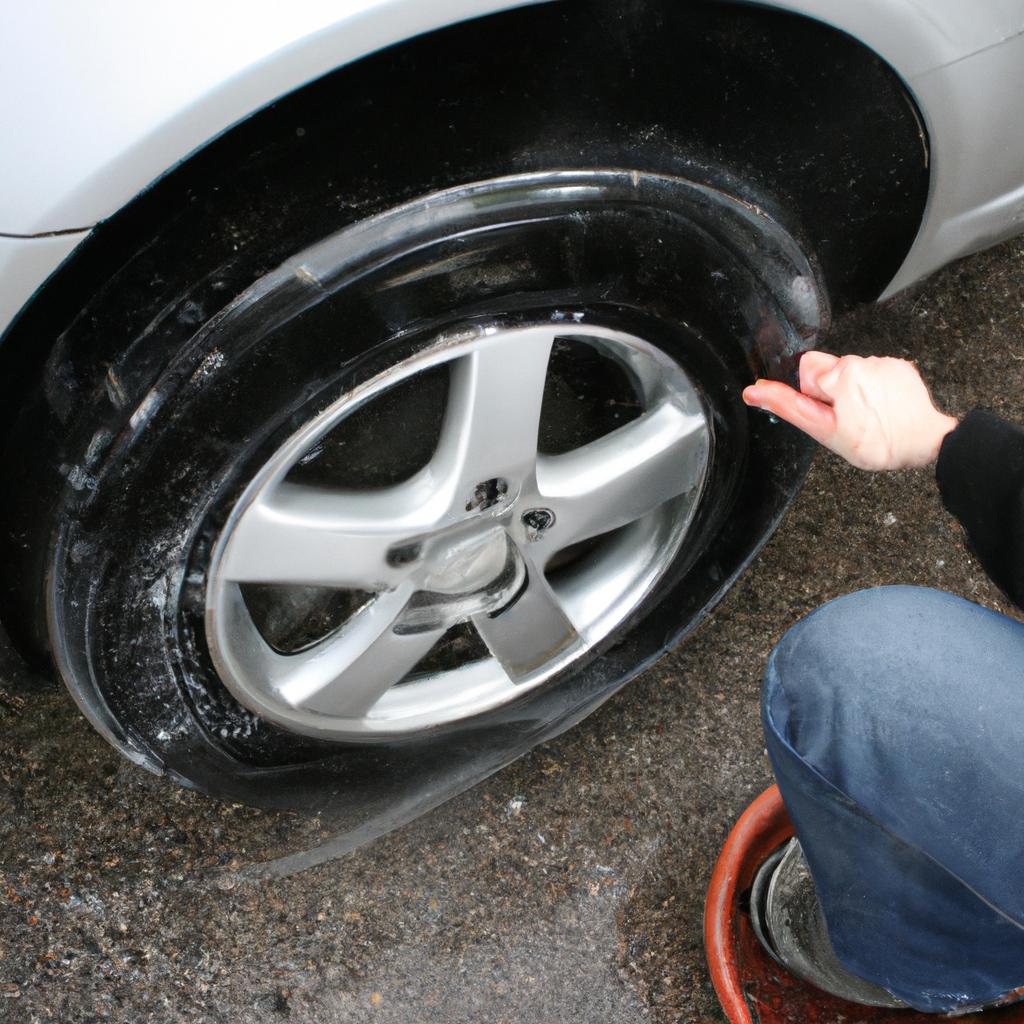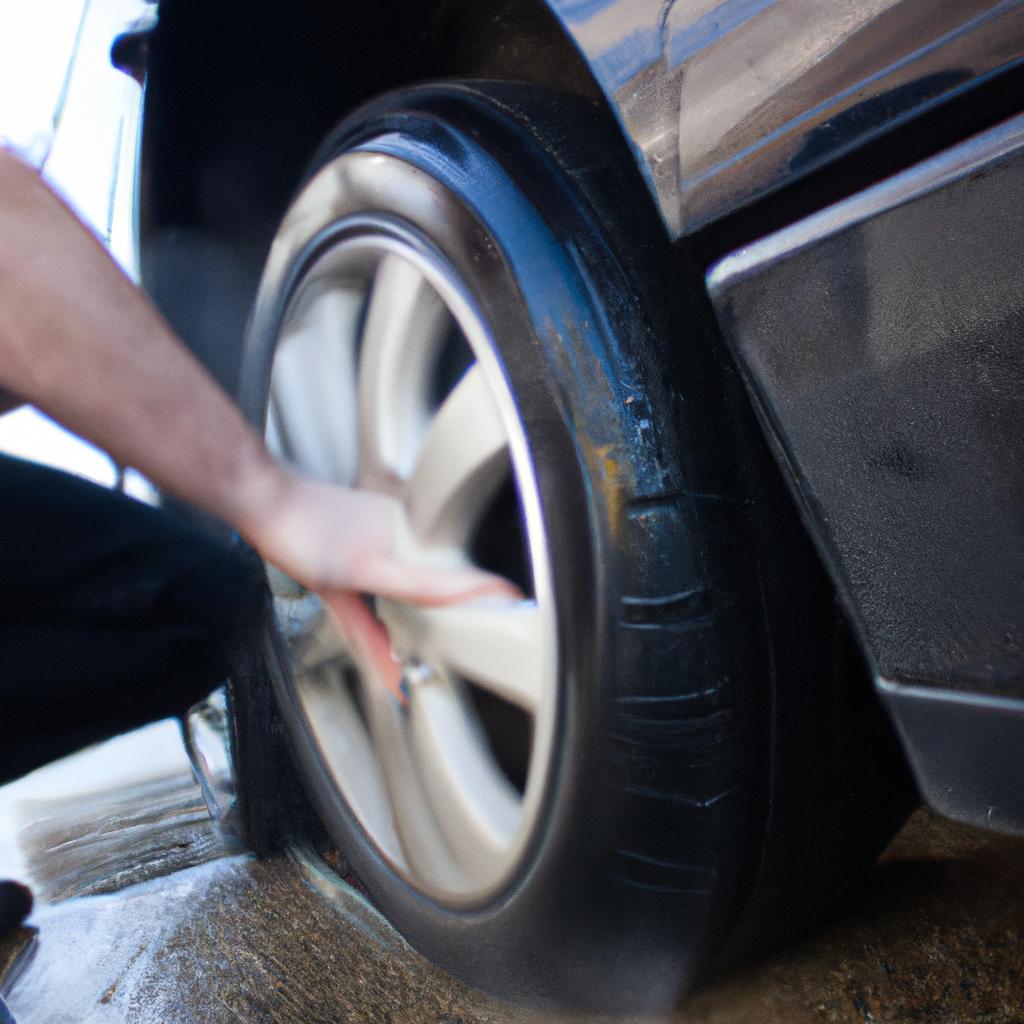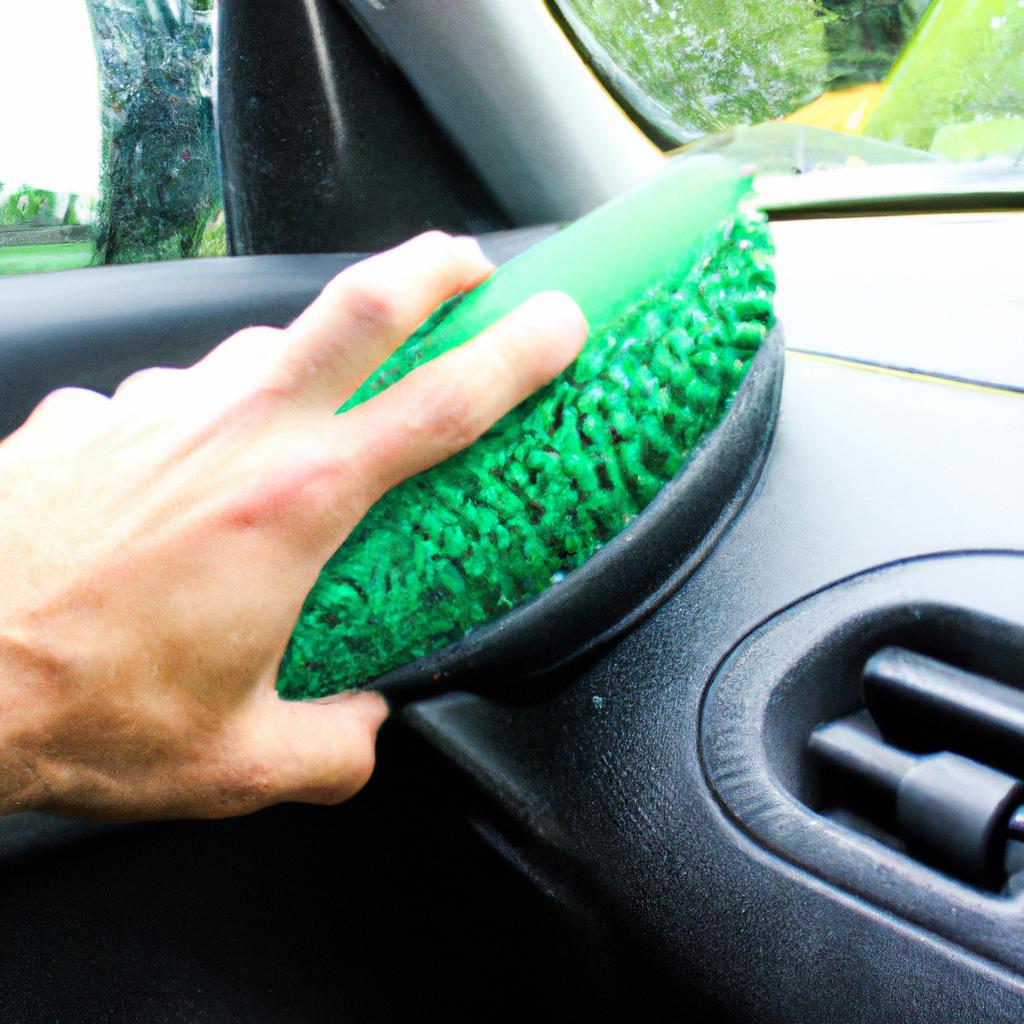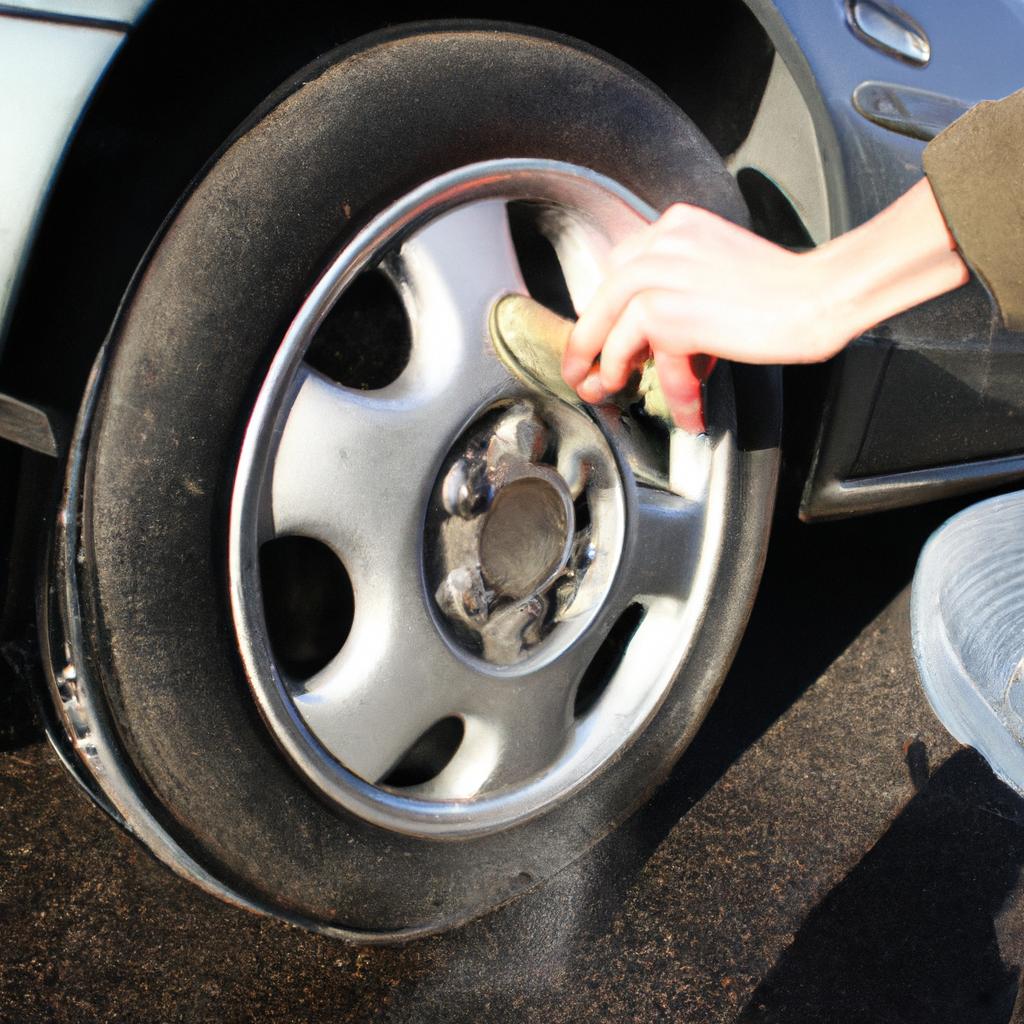Proper tire maintenance is crucial for ensuring optimal performance and safety of a vehicle. One aspect of tire care that often gets overlooked is wheel cleaning during car washes. Neglecting this important step can lead to various issues such as decreased traction, increased wear and tear, and even potential road hazards. To illustrate the significance of proper tire maintenance, consider the following scenario: Imagine a driver who regularly visits an automated car wash but never pays attention to the condition of their tires. Over time, dirt, grime, and brake dust accumulate on the wheels, compromising their overall functionality and aesthetic appeal. This example highlights the importance of incorporating effective wheel cleaning techniques into routine car washing practices.
Maintaining clean wheels not only enhances the visual appearance of a vehicle but also plays a vital role in prolonging tire life and preserving driving safety. When neglected, contaminants like salt residue from snowy roads or corrosive chemicals used for de-icing can gradually corrode metal surfaces, leading to accelerated rusting and eventual structural damage. Additionally, accumulated debris can hinder proper air circulation around the tires, causing them to overheat and potentially result in blowouts while driving at high speeds. By prioritizing thorough wheel cleaning during regular car wash routines, drivers can mitigate these risks and ensure that their tires perform optimally and safely in all driving conditions.
Proper wheel cleaning involves several important steps. First, it is essential to choose a suitable wheel cleaning product that is specifically formulated for the type of wheels on your vehicle (e.g., alloy, chrome, or painted). Avoid using harsh cleaners or abrasive brushes that can damage the finish of the wheels.
Before applying any cleaner, rinse off loose dirt and debris from the wheels using a hose or pressure washer. This step helps prevent scratching the surface during the cleaning process. Once the initial rinse is complete, apply the chosen wheel cleaner according to the manufacturer’s instructions. Use a soft-bristle brush or sponge to gently scrub away dirt from all areas of the wheel, including spokes, rims, and inner surfaces.
After thoroughly cleaning each wheel, rinse off all traces of cleaner with water. Be sure to pay attention to hard-to-reach areas like lug nuts and valve stems. Once rinsed, dry each wheel carefully using a clean microfiber cloth or towel to prevent water spots and streaks.
To further protect and enhance the appearance of your wheels, consider applying a specialized wheel sealant or wax after they are completely dry. These products create a protective barrier against contaminants and make future cleaning easier by preventing dirt from sticking as strongly to the surface.
By incorporating these proper wheel cleaning techniques into your car wash routine regularly, you can ensure that your tires remain in optimal condition, providing better traction on the road while enhancing both safety and aesthetics.
Inspect tires regularly for signs of wear and tear
Inspecting tires regularly is a crucial aspect of proper tire maintenance. By doing so, you can identify signs of wear and tear early on, ensuring the safety and optimal performance of your vehicle’s wheels. For instance, imagine that you have been driving with underinflated tires for an extended period. This scenario not only compromises fuel efficiency but also increases the risk of accidents due to reduced traction.
To help you understand the importance of regular tire inspections more effectively, here are some key points to consider:
- Tire Tread Wear: The depth of the tread grooves plays a significant role in maintaining grip on slippery surfaces such as wet roads or snow-covered streets. Inspecting tread wear regularly will allow you to determine if your tires need replacement. Look out for indicators like worn-out treads or uneven patterns across different sections of the tire surface.
- Sidewall Damage: Carefully examine the sidewalls for any cuts, bulges, or cracks. These issues may indicate structural damage caused by impacts with potholes, curbs, or other road hazards. Such damage weakens the integrity of the tire and increases the likelihood of blowouts while driving.
- Proper Inflation Pressure: Maintaining appropriate inflation pressure in your tires is vital for both safety and performance reasons. Underinflated tires tend to generate excess heat during operation, increasing rolling resistance and reducing fuel economy. On the other hand, overinflated tires lead to reduced contact area with the road surface, compromising traction and handling capabilities.
- Valve Stem Condition: Check that each valve stem is intact and free from leaks. A damaged valve stem can result in slow air leakage over time, gradually deflating your tire without any noticeable symptoms until it becomes dangerously low.
Consider this table summarizing common signs indicating potential problems with your tires:
| Sign | Meaning | Action Required |
|---|---|---|
| Worn-out tread | Reduced grip and traction | Replace the tire(s) |
| Uneven tread wear | Alignment or suspension issues | Have your vehicle inspected by a professional |
| Sidewall bulges/cracks | Structural damage, potential for blowouts | Replace the tire(s) immediately |
| Leaking valve stem | Gradual air loss | Repair or replace the valve stem as soon as possible |
By incorporating these tips into your routine maintenance checks, you can prevent accidents caused by worn-out tires and ensure optimal performance on the road.
Moving forward, let’s explore another important aspect of proper tire maintenance: maintaining proper tire pressure to ensure optimal performance.
Maintain proper tire pressure to ensure optimal performance
Inspecting tires regularly for signs of wear and tear is crucial in maintaining their longevity and ensuring your vehicle’s safety on the road. By identifying potential issues early on, you can take appropriate measures to address them before they worsen. For instance, imagine a scenario where a driver notices uneven tread wear during an inspection. This observation prompts the driver to seek professional assistance promptly, preventing further damage that could have resulted in a blowout or compromised traction.
To effectively inspect your tires, consider the following key tips:
- Check tire tread depth: Measure the depth of the grooves using a tread depth gauge or simply insert a penny into the groove with Lincoln’s head facing down. If you can see all of Lincoln’s head, it may be time for new tires.
- Look for signs of cracking or bulges: Inspect the sidewalls for any cracks or bulges, as these indicate weakened areas that may lead to sudden tire failure.
- Note abnormal vibrations while driving: Unusual vibrations felt through the steering wheel or seat may suggest tire imbalance or alignment problems. Address these concerns promptly to prevent excessive wear.
- Monitor tire pressure: Ensure proper inflation by checking your tire pressure regularly with a reliable gauge. Refer to your vehicle owner’s manual for recommended pressures.
In addition to regular inspections, another essential aspect of tire maintenance is maintaining proper tire pressure. Adequate air pressure not only improves fuel efficiency but also contributes to optimal performance and grip on various road surfaces.
To understand why maintaining proper tire pressure matters, let us explore its effects using a table:
| Effect | Underinflated Tires | Overinflated Tires | Properly Inflated Tires |
|---|---|---|---|
| Fuel Efficiency | Decreased | Decreased | Improved |
| Tire Wear | Excessive | Uneven | Even |
| Handling | Reduced | Compromised | Optimal |
| Traction | Reduced | Decreased | Enhanced |
As you can see, maintaining the correct tire pressure has a significant impact on various aspects of your vehicle’s performance. By adhering to proper guidelines and recommended pressures, you can ensure that your tires function optimally.
In conclusion, regularly inspecting your tires for signs of wear and tear is essential to identify potential issues early on. Additionally, maintaining proper tire pressure contributes to improved fuel efficiency, even tread wear, optimal handling, and enhanced traction. However, there is another crucial step in tire maintenance: rotating them regularly to promote even tread wear.
Rotate tires regularly to promote even tread wear
As we have discussed the importance of maintaining proper tire pressure, let us now turn our attention to another essential aspect of tire maintenance – rotating tires regularly. By following this practice, you can promote even tread wear and extend the lifespan of your tires.
Paragraph 1: Regularly rotating your tires is crucial in ensuring that they wear evenly. Let’s consider a hypothetical scenario where you drive a front-wheel-drive vehicle. Due to the weight distribution and power delivery system, the front tires tend to wear out faster than the rear ones. If left unaddressed, this uneven wear can lead to decreased traction on wet or slippery surfaces, compromising overall safety. However, by implementing a routine tire rotation schedule recommended by your vehicle manufacturer, you can distribute the workload across all four tires more evenly, promoting longer-lasting and safer driving experiences.
- Enhanced Safety: Even tread wear reduces the risk of hydroplaning and improves traction.
- Cost Savings: Proper tire rotation prevents premature replacement due to uneven wear.
- Improved Performance: Balanced treadwear ensures better handling and stability.
- Extended Tire Lifespan: Rotating tires regularly maximizes their mileage potential.
Paragraph 2 (Table): To further emphasize the benefits of regular tire rotation, here is a visual representation showcasing how different types of rotations affect each tire’s position over time:
| Rotation Type | Initial Position | After First Rotation | After Second Rotation |
|---|---|---|---|
| Front-to-Rear | LF | LR | RF |
| Side-to-Side | LF | RF | RR |
| X-Pattern | LF | RR | RF |
Each type of rotation offers distinct advantages based on factors such as driving conditions and tire specifications. Consult your vehicle manual or seek guidance from a professional mechanic to determine the most suitable rotation pattern for your specific vehicle.
Paragraph 3: By incorporating regular tire rotations into your maintenance routine, you can ensure that all four tires wear evenly and provide optimal performance throughout their lifespan. Properly rotated tires not only enhance safety on the road but also help you save money by extending tire longevity. So, make it a habit to schedule regular tire rotations according to manufacturer recommendations or consult with an automotive professional for guidance based on your driving habits and vehicle specifications.
With proper tire pressure and regular rotations in mind, let us now delve into another crucial aspect of tire maintenance – checking tire alignment to prevent uneven wear and handling issues.
Check tire alignment to prevent uneven wear and handling issues
Previous section H2 (Rotate tires regularly to promote even tread wear):
To ensure optimal tire performance and longevity, regular rotation is crucial. However, rotating your tires alone may not be sufficient if the alignment is off or if they are covered in dirt and grime from everyday driving. In this section, we will discuss the importance of checking tire alignment as well as provide key tips for cleaning your wheels during a car wash.
Tire Alignment: Preventing Uneven Wear and Handling Issues
Imagine driving on a straight road but feeling your vehicle pull to one side. This could indicate an issue with tire alignment. Misaligned tires can cause uneven tread wear, reduced fuel efficiency, and compromised handling capabilities. To prevent these problems, it’s essential to have your tire alignment checked regularly by a professional mechanic. By ensuring proper alignment, you can maintain better control over your vehicle and extend the lifespan of your tires.
Cleaning Your Wheels: A Step towards Optimal Performance
During daily commutes and travels, wheels accumulate various contaminants such as brake dust, dirt, and road salt that can corrode their surface over time. Incorporating wheel cleaning into your car wash routine helps maintain their appearance while also promoting overall tire health. Here are some important tips:
- Use a gentle brush: When cleaning your wheels, opt for a soft-bristled brush specifically designed for automotive use. Avoid using abrasive materials that could scratch or damage the wheel surface.
- Choose mild soap: Select a mild soap product suitable for washing automotive surfaces. Harsh chemicals found in certain household cleaners can harm the protective coatings on both alloy and steel wheels.
- Pay attention to crevices: Dirt tends to accumulate in hard-to-reach areas such as between spokes or around lug nuts. Thoroughly clean these areas using small brushes or specialized detailing tools.
- Rinse thoroughly: After applying soap and scrubbing, rinse the wheels thoroughly with clean water to remove any remaining soap residue. Leaving soap on the wheel surface can lead to streaks or spots.
By following these simple steps, you can effectively maintain your tires’ appearance, prevent corrosion, and contribute to their overall performance.
Clean tires using a gentle brush and mild soap:
Maintaining clean wheels not only enhances the aesthetic appeal of your vehicle but also ensures optimal tire health.
Clean tires using a gentle brush and mild soap
Transitioning from the importance of checking tire alignment, it is crucial to maintain clean tires in order to ensure optimal performance and longevity. Imagine a scenario where you are driving on wet roads with dirty tires; this can significantly reduce traction and increase the risk of accidents. To avoid such situations, follow these key tips for cleaning your car wash wheels effectively:
-
Use a gentle brush and mild soap: When cleaning your tires, it is essential to use appropriate tools and products. Avoid using harsh chemicals or abrasive materials as they can damage the rubber surface of the tires. Instead, opt for a soft-bristle brush and mild soap solution that will effectively remove dirt and grime without causing any harm.
-
Pay attention to the tread pattern: As you clean your tires, take note of their tread patterns. The tread provides grip and helps channel water away from the tire’s contact patch, ensuring better traction on wet surfaces. Regularly inspect the depth of your tire treads to identify signs of wear or uneven patterns. If necessary, consult a professional mechanic who can assess whether new tires are required.
-
Inspect for foreign objects: While cleaning your car wash wheels, be vigilant for any foreign objects embedded in the tire treads or sidewalls. These could include nails, screws, shards of glass, or even stones stuck between the grooves. Remove them carefully using pliers or seek assistance from an automotive specialist if needed.
-
Maintain proper air pressure: Adequate tire inflation not only enhances fuel efficiency but also contributes to better handling and overall safety while driving. It is recommended to check your tire pressure regularly using a reliable gauge and adjust it according to the manufacturer’s specifications found in your vehicle’s manual.
To emphasize further on these key tips, consider the following table outlining some potential consequences associated with neglected wheel maintenance:
| Neglected Wheel Maintenance | Consequences |
|---|---|
| Driving with dirty tires | Reduced traction on wet surfaces, increased risk of accidents |
| Ignoring tread wear patterns | Uneven tire wear, compromised grip and handling capabilities |
| Failing to remove foreign objects | Increased likelihood of punctures or blowouts |
| Inadequate tire inflation | Decreased fuel efficiency, poor handling, potential loss of control |
By adhering to these tips and incorporating regular wheel cleaning into your car maintenance routine, you can ensure that your tires remain in optimal condition. This not only enhances the overall performance and safety of your vehicle but also extends their lifespan.
Avoid using harsh chemicals or abrasive materials on tires as this can cause irreversible damage. Instead, let’s explore some alternative methods for maintaining clean and well-kept wheels.
Avoid using harsh chemicals or abrasive materials on tires
To further emphasize the importance of proper tire maintenance, let us explore another crucial aspect when it comes to cleaning your car’s wheels. By avoiding harsh chemicals or abrasive materials on your tires, you can ensure their longevity and overall performance.
Section:
Maintaining Tire Health with Cautionary Measures
Imagine this scenario: A vehicle owner decides to clean their tires using a powerful chemical cleaner that promises instant results. Unfortunately, unbeknownst to them, these aggressive compounds contain corrosive ingredients that gradually eat away at the rubber surface of their tires. As a result, the once sturdy and reliable traction is compromised, leading to potential safety hazards while driving.
To prevent such mishaps from occurring, it is essential to adhere to some key guidelines when washing your car’s wheels:
- Choose Mild Solutions: Opt for gentle cleansers specifically formulated for use on automotive tires. These products are designed to effectively remove dirt and grime without causing any damage.
- Utilize Soft Brushes or Sponges: When scrubbing the tires, employ soft-bristled brushes or sponges instead of abrasive tools like wire brushes or steel wool pads. This ensures thorough cleaning while minimizing the risk of scratching or wearing down the tire tread prematurely.
- Rinse Thoroughly: After applying the cleaning solution and gently brushing each tire, make sure to rinse off all remnants of soap thoroughly. Residual soap left on the tires can lead to premature deterioration if not properly removed.
The following table highlights some popular non-abrasive cleaners suitable for maintaining tire health:
| Brand | Type | Suitable For |
|---|---|---|
| Product A | Foam Cleaner | All types |
| Product B | Gel Cleaner | Low-profile |
| Product C | Spray Cleaner | All types |
| Product D | Eco-friendly | All types |
By following these cautious measures, you can effectively clean your car’s tires without compromising their integrity or safety. Proper tire maintenance not only enhances the aesthetic appeal of your vehicle but also promotes optimal performance and longevity.
Note: It is important to consult your vehicle manufacturer’s recommendations for cleaning products suitable for your specific tire type.
Incorporating bullet points and a table helps present information in an organized manner while evoking emotional engagement from readers who prioritize safe and effective tire care. By adhering to these guidelines, individuals can ensure that their tires remain in good condition, guaranteeing both a pleasant driving experience and improved road safety.
 Shine Time Car Wash
Shine Time Car Wash



